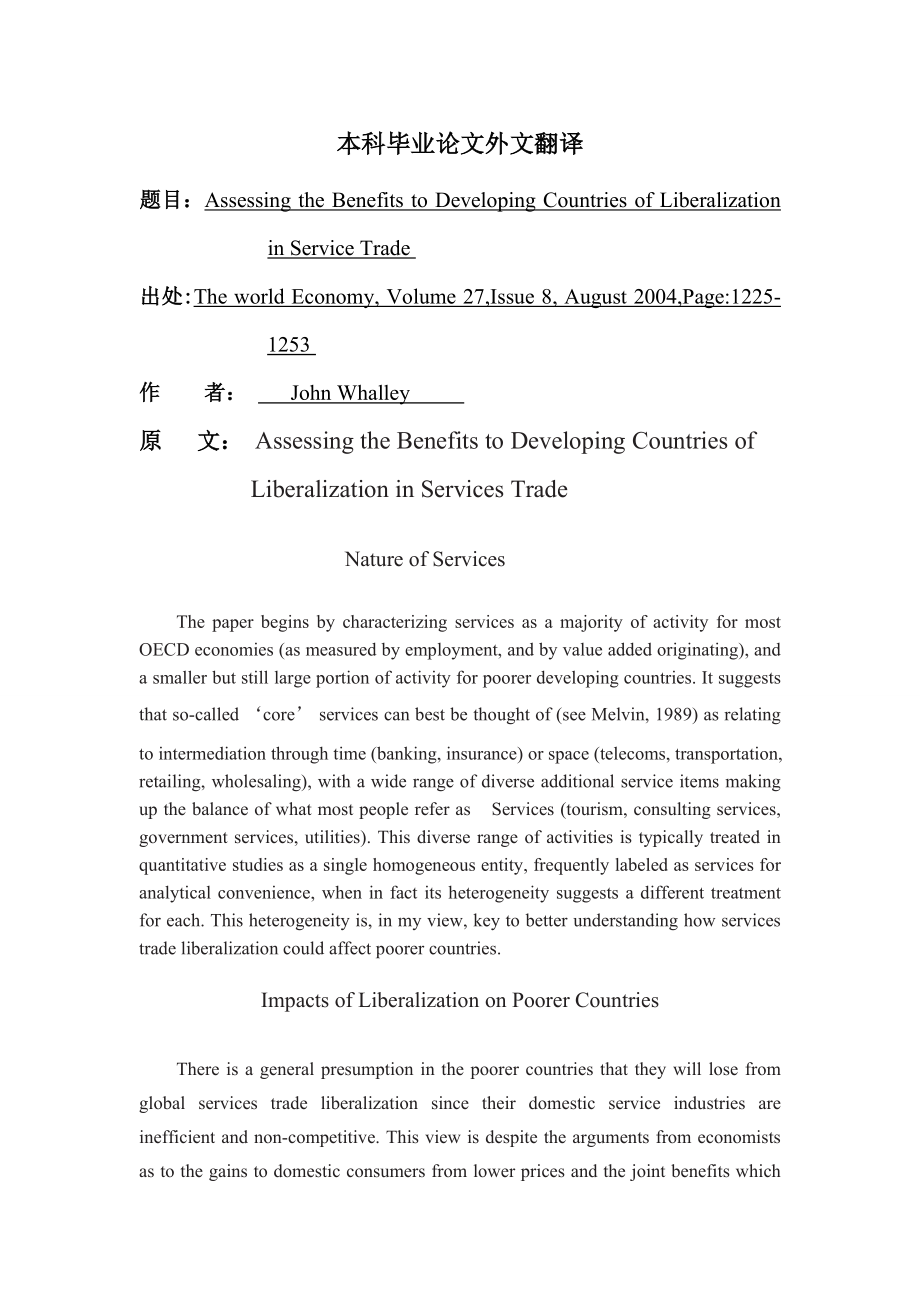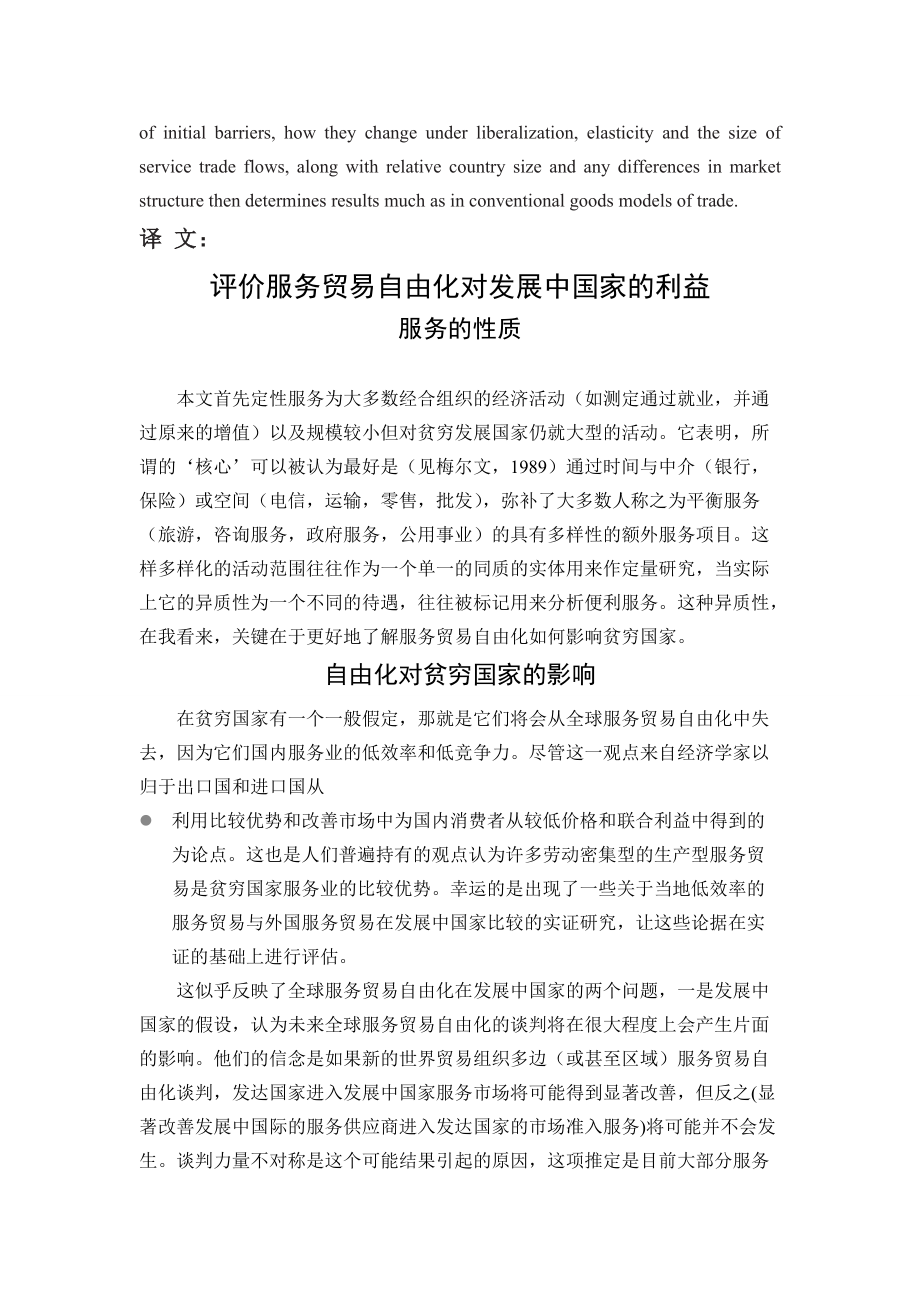




版權說明:本文檔由用戶提供并上傳,收益歸屬內(nèi)容提供方,若內(nèi)容存在侵權,請進行舉報或認領
文檔簡介
1、本科畢業(yè)論文外文翻譯題目:Assessing the Benefits to Developing Countries of Liberalization in Service Trade 出處:The world Economy, Volume 27,Issue 8, August 2004,Page:1225-1253 作 者: John Whalley 原 文: Assessing the Benefits to Developing Countries ofLiberalization in Services TradeNature of ServicesThe paper begin
2、s by characterizing services as a majority of activity for most OECD economies (as measured by employment, and by value added originating), and a smaller but still large portion of activity for poorer developing countries. It suggests that so-called core services can best be thought of (see Melvin,
3、1989) as relating to intermediation through time (banking, insurance) or space (telecoms, transportation, retailing, wholesaling), with a wide range of diverse additional service items making up the balance of what most people refer as Services (tourism, consulting services, government services, uti
4、lities). This diverse range of activities is typically treated in quantitative studies as a single homogeneous entity, frequently labeled as services for analytical convenience, when in fact its heterogeneity suggests a different treatment for each. This heterogeneity is, in my view, key to better u
5、nderstanding how services trade liberalization could affect poorer countries. Impacts of Liberalization on Poorer CountriesThere is a general presumption in the poorer countries that they will lose from global services trade liberalization since their domestic service industries are inefficient and
6、non-competitive. This view is despite the arguments from economists as to the gains to domestic consumers from lower prices and the joint benefits which accrue to both exporting and importing countries from exploiting comparative advantage and improved market access opportunities abroad. It is also
7、despite the commonly held view that the production of many services are labor intensive, which economists believe should be the source of comparative advantage for poorer developing countries in services provision. There unfortunately appear to be few if any studies of the relative inefficiency of l
8、ocal versus Foreign Service providers in developing country service markets which allow the strength of these arguments to be evaluated on empirical grounds.This caution towards global services trade liberalization in the developing world seems to reflect two concerns. One is the general assumption
9、in the developing world that any future negotiated global liberalization of services trade will be largely one sided in the results it will yield. Their belief is that if new WTO multilateral (or even regional) services liberalization is negotiated, developed country service providers will likely ga
10、in significantly improved access to developing country service markets, but the converse (significantly improved access for developing country service providers to develop country service markets) will likely not happen. Asymmetry in negotiating power is one reason cited for this possible outcome. T
11、he presumption is that the present regulatory structure for most service market segments will remain in place in OECD countries, and few significant improvements in access to developed country markets for developing country service providers will occur. This outcome, for instance, is reflected in re
12、cent US bilateral agreements, including the US-Chile agreement. In reality, through the process of ongoing regulatory reform in the OECD, changes are in fact being made in market access arrangements for developing country service providers, though these are not necessarily reflected in scheduled .An
13、other important and neglected dimension to this conclusion is South-South trade, and the potential that developing countries have much to gain from liberalization of markets in other developing countries. The point is that in terms of model-based (or quantitative) evaluations of the impacts of servi
14、ces trade liberalization, were genuine two-sided liberalization to take place with their low wage rates, developing country providers could well benefit. This is especially so if there are scales economies in service provision (as in banking, for instance). Most of the available studies of what bene
15、fits might flow from services liberalization assume there will be full multilateral opening of service markets, and results of studies must be interpreted in light of this presumption. If one-sided liberalization is the expected outcome, developing countries may well remain opposed to liberalization
16、 on the grounds it is non-reciprocal despite the results of studies.The second caution that developing countries express is the nature and size of the adjustments in domestic economies which services liberalization may imply. One dimension of adjustment relates to potential foreign majority ownershi
17、p and control of provision in key service sectors, and the related security and cultural concerns. Foreign entities having access to and control over bank records and financial information of domestic residents, for instance, is seen in some countries as unacceptable. Also, a vibrant and vital domes
18、tic broadcast or film industry may be viewed as integral to national cultural identity. Added to such concerns is the potential size of labor market adjustments if domestic banks are displaced by foreign banks, domestic by foreign airlines, and other large changes in the organization of labor-intens
19、ive sectors which might follow after liberalization Against this background, the paper identifies three central issues which existing literature on the quantification of the potential benefits to developing countries of service trade liberalization raises. For simplicity in the discussion of studies
20、 assume, as in the literature, that this is in fact multilateral liberalization rather than the unilateral liberalization developing countries presume it may well be in reality. The first is the representation of and measurement of barriers to services trade in individual countries, and the associat
21、ed issue of measuring the size of services trade itself. Both the level and composition of global services trade is poorly measured at present because there is no formal customers clearance for services trade. Despite this, the literature Consensus is that services trade is large (the WTO put it at
22、30 per cent of combined trade in goods and services), and growing (at perhaps double the rate of goods trade). Current information on barriers to flows of services trade reflects a number of sources. One measures the quantity impacts from various restrictions as estimated by economic models. Another
23、 uses estimates of price differentials for across domestic and foreign service providers across national markets. Yet another is frequency data showing how often regulatory measures are used in particular service segments in particular countries. Tax equivalents are used in some of the literature to
24、 capture associated barriers to FDI flows which might otherwise accompany freer service trade flows In the paper I suggest that these are major conceptual problems with all of these estimates of the size of barriers, while acknowledging that no other meaningful data exist which can be used and many
25、problems inevitably arise with whatever approach is followed. By way of illustration, frequency data do not allow users to differentiate between those barriers which restrict trade (i.e. are binding constraints on trade), and those which do not restrict trade because they are redundant (i.e. are non
26、-binding constraints). Neither do studies substantively enumerate and represent the various ways in which restrictions on services trade apply and how these affect the assessment of impact, nor do they assess the relative severity of barriers. To an economist working on the impacts of distortions of
27、 trade, available barrier estimates from frequency data in no way provide meaningful estimates of marginal barriers to trade. Another example is that if data on costs of service provision in different markets are obtained, any differences across markets may merely reflect differences in domestic reg
28、ulatory environments and not barriers to entry for Foreign Service providers. Price differences across countries for services can also reflect quality differentials across countries rather than barriers. Using model results to infer barriers to trade can yield outcomes that quantity impacts from bar
29、riers may be negative from model residuals even where it is clear that binding restraints on trade apply. A second issue discussed is the interpretation of results from existing model based literature seeking to quantify the impacts of trade liberalization in services. Most of what is available invo
30、lves numerical simulation exercises using (Typically global) general equilibrium models based on conventional models of trade liberalization in goods (see Whalley, 1985). In these exercises, producer services are typically identified as an input into intermediate production and barriers to service t
31、rade are represented in the form of ad valorem tariff-like restrictions. These can be in tax-equivalent (for FDI flows) or tariff-equivalent (for service flows) form. The size of initial barriers, how they change under liberalization, elasticity and the size of service trade flows, along with relati
32、ve country size and any differences in market structure then determines results much as in conventional goods models of trade.譯 文: 評價服務貿(mào)易自由化對發(fā)展中國家的利益服務的性質本文首先定性服務為大多數(shù)經(jīng)合組織的經(jīng)濟活動(如測定通過就業(yè),并通過原來的增值)以及規(guī)模較小但對貧窮發(fā)展國家仍就大型的活動。它表明,所謂的核心可以被認為最好是(見梅爾文,1989)通過時間與中介(銀行,保險)或空間(電信,運輸,零售,批發(fā)),彌補了大多數(shù)人稱之為平衡服務(旅游,咨詢服務,政府服
33、務,公用事業(yè))的具有多樣性的額外服務項目。這樣多樣化的活動范圍往往作為一個單一的同質的實體用來作定量研究,當實際上它的異質性為一個不同的待遇,往往被標記用來分析便利服務。這種異質性,在我看來,關鍵在于更好地了解服務貿(mào)易自由化如何影響貧窮國家。自由化對貧窮國家的影響在貧窮國家有一個一般假定,那就是它們將會從全球服務貿(mào)易自由化中失去,因為它們國內(nèi)服務業(yè)的低效率和低競爭力。盡管這一觀點來自經(jīng)濟學家以歸于出口國和進口國從l Bnwn shuxin dngxng wi du d dush jng h zzh d dush jngj hudng fw (r jiy cdng, bng tnggu zngz
34、h de wnjin), yj dxng hudng de gum jio xio, dn rng du pnqing de f zhn zhng guji de bfn.l 字典 - 查看字典詳細內(nèi)容利用比較優(yōu)勢和改善市場中為國內(nèi)消費者從較低價格和聯(lián)合利益中得到的為論點。這也是人們普遍持有的觀點認為許多勞動密集型的生產(chǎn)型服務貿(mào)易是貧窮國家服務業(yè)的比較優(yōu)勢。幸運的是出現(xiàn)了一些關于當?shù)氐托实姆召Q(mào)易與外國服務貿(mào)易在發(fā)展中國家比較的實證研究,讓這些論據(jù)在實證的基礎上進行評估。這似乎反映了全球服務貿(mào)易自由化在發(fā)展中國家的兩個問題,一是發(fā)展中國家的假設,認為未來全球服務貿(mào)易自由化的談判將在很大程度上
35、會產(chǎn)生片面的影響。他們的信念是如果新的世界貿(mào)易組織多邊(或甚至區(qū)域)服務貿(mào)易自由化談判,發(fā)達國家進入發(fā)展中國家服務市場將可能得到顯著改善,但反之(顯著改善發(fā)展中國際的服務供應商進入發(fā)達國家的市場準入服務)將可能并不會發(fā)生。談判力量不對稱是這個可能結果引起的原因,這項推定是目前大部分服務細分市場的監(jiān)管架構將維持在經(jīng)合組織國家,這些國家將對發(fā)達國家市場的服務供應商得到明顯改善。這一成果,例如,反映在最近美國的雙邊協(xié)定,包括美國和智力的協(xié)議。事實上,通過經(jīng)合組織正在進行的監(jiān)管改革進程,在市場準入方面的改變其實已經(jīng)為發(fā)展中國家服務供應商做出安排,盡管這些并不一定在日程上反映出來。另一個忽視這個結論的重要層面是南南合作貿(mào)易,發(fā)展中國家有從其他發(fā)展中國家自由化得到好處的潛力。問題的關鍵是,在模型為基礎的(或定量)的服務貿(mào)易自由化影響的評估方面,因為低工資率會發(fā)生真正的雙面自由化,發(fā)展中國家的供應商很可能真正受益。這尤其是否存在服務貿(mào)易的規(guī)模經(jīng)濟,現(xiàn)有的大多數(shù)研究關于服務貿(mào)易自由化流入的好處,都假定服務貿(mào)易多邊市場完全開放,且研究結果必須以本推定加以解釋。如果片
溫馨提示
- 1. 本站所有資源如無特殊說明,都需要本地電腦安裝OFFICE2007和PDF閱讀器。圖紙軟件為CAD,CAXA,PROE,UG,SolidWorks等.壓縮文件請下載最新的WinRAR軟件解壓。
- 2. 本站的文檔不包含任何第三方提供的附件圖紙等,如果需要附件,請聯(lián)系上傳者。文件的所有權益歸上傳用戶所有。
- 3. 本站RAR壓縮包中若帶圖紙,網(wǎng)頁內(nèi)容里面會有圖紙預覽,若沒有圖紙預覽就沒有圖紙。
- 4. 未經(jīng)權益所有人同意不得將文件中的內(nèi)容挪作商業(yè)或盈利用途。
- 5. 人人文庫網(wǎng)僅提供信息存儲空間,僅對用戶上傳內(nèi)容的表現(xiàn)方式做保護處理,對用戶上傳分享的文檔內(nèi)容本身不做任何修改或編輯,并不能對任何下載內(nèi)容負責。
- 6. 下載文件中如有侵權或不適當內(nèi)容,請與我們聯(lián)系,我們立即糾正。
- 7. 本站不保證下載資源的準確性、安全性和完整性, 同時也不承擔用戶因使用這些下載資源對自己和他人造成任何形式的傷害或損失。
最新文檔
- 《礦井通風與安全》課件
- 榮昌別墅地毯施工方案
- 2025至2031年中國單推氮窯行業(yè)投資前景及策略咨詢研究報告
- 2025年抵押擔保合同范本
- 2025至2030年中國防松片數(shù)據(jù)監(jiān)測研究報告
- 2025至2030年中國鋼材材質機械性能萬能試驗機數(shù)據(jù)監(jiān)測研究報告
- 慈溪機房地坪施工方案
- 2025年合同違約與解除合同的經(jīng)濟補償規(guī)定
- 底層石膏工程施工方案
- 智慧商場新零售營銷解決方案
- 13《貓》 第二課時 課件
- 棒壘球課教學大綱
- 地鐵保潔安全培訓
- 《人體內(nèi)物質的運輸》血液循環(huán)共23張
- 工程總承包項目風險管理
- 延伸護理服務的課件
- 意大利(百得)TBG 系列燃燒機說明書
- 污水處理設施運維服務投標方案(技術方案)
- 冠脈搭橋術個案查房
- 李白《長干行》教學課件
- 駕駛員日常安全教育培訓大綱

評論
0/150
提交評論